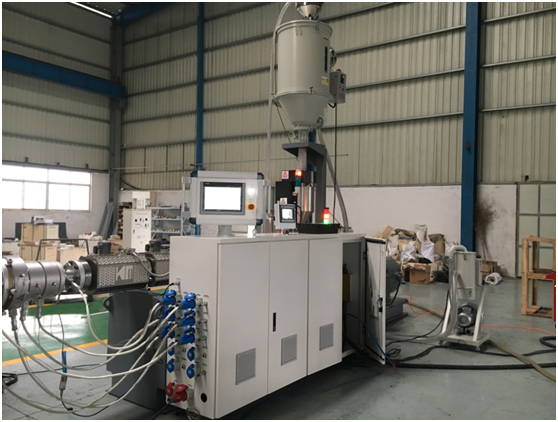An extruder is a common plastic processing equipment that converts solid plastic raw materials into continuous profiles such as pipes, sheets, films, etc. through heating, plasticization, and pressure. This equipment is widely used in the production of various plastic products. This article will provide a detailed analysis of the working principle of the extruder and explore its operational characteristics at each stage.
1. Overview of structural composition and function
The core components of an extruder include the feeding system, screw, barrel (material barrel), heating and cooling system, driving device, and mold.
Feeding system: responsible for evenly feeding raw materials into the interior of the machine.
Screw: Under the drive of the motor, it rotates, mixes, compresses, and advances the material forward.
Cylinder: Provides a sealed space for heating to melt the material.
Heating and cooling system: controls the temperature throughout the entire processing process.
Mold: determines the shape and size of the final product.
These parts work together to complete the entire process from raw materials to finished products.

2. Raw material preparation and feeding process of extruder
Before production, plastic particles or powders need to be used as raw materials and undergo pre-drying treatment to remove moisture and prevent the occurrence of bubbles during subsequent processing, which may affect quality. Next, the raw materials enter the feed inlet of the extruder through gravity or forced conveying. Sometimes, in order to precisely control the supply, measuring equipment is used to ensure the accuracy of the supply quantity for each batch.
3. Material melting and mixing
After entering the extruder, the raw materials move forward under the push of the screw rotation. As the cylinder heats up, the internal temperature gradually rises and the plastic particles begin to melt. The design of the screw enables it to shear and compress materials, ensuring thorough mixing and uniform plasticization. Different screw designs are suitable for different types of materials, so choosing the appropriate screw is crucial.
4. Plasticization and shaping
When the material enters the plasticizing zone of the extruder, the design focus of the screw is to ensure that the material reaches the ideal melting state. This area requires stable pressure to ensure that the material has appropriate fluidity and viscosity for subsequent molding operations. When approaching the exit, the material is given the desired shape through the mold. The design of the mold determines the cross-sectional profile of the product, while the extrusion speed and pressure adjustment affect the final product quality.
5. Cooling, solidification, cutting, and winding
When molten plastic is extruded through a mold, it remains in a high-temperature state and its shape is unstable. At this point, rapid cooling is required to solidify. Usually, water or air cooling methods are used. For example, long-strip products will be immersed in a cold water pool to solidify, while thin-film products may be cooled by blowing and air cooling. Some products may undergo surface treatment during this process to improve their appearance and texture or enhance their characteristics. The final product will be cut or wound as needed for storage or further processing.
6. Conclusion
As a key equipment in plastic processing, the extruder plays an important role in modern manufacturing due to its high efficiency and stable performance. Understanding the working principle of extruders can help optimize production processes and develop more high-quality new plastic products. With the advancement of technology, extruders are developing towards intelligence and automation, providing broader application prospects for the plastic processing industry.
